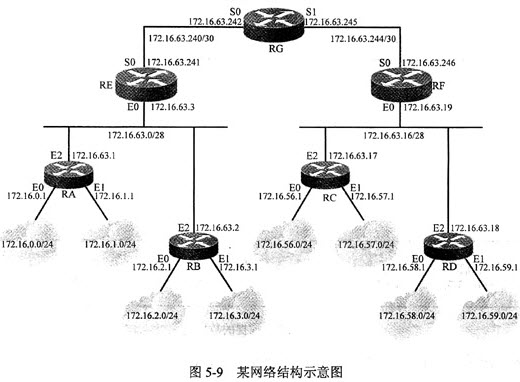请根据如图所示的网络结构回答下列问题。

某网络结构示意图
请填写表1中路由器RG的路由表项①~⑤

参考答案:
①63.0/28
②172.16.63.16/28或172.16.56.0/22
③172.16.63.241
④172.16.56.0/22或172.16.63.16/28,但需与②不同
⑤S1
解析:
在如图所示的连接路由器的接口中,标有S0 (Serial 0)、S1(Setral 1)的是串行线路标记,E0、E1、E2表示Ethernet接口。其中,路由器RG通过两条专线S0、S1分别与路由器RE、RF连接;路由器RE通过两个Ethernet接口分别与路由器RA、RB连接;路由器RF通过两个Ethernet接口分别与路由器RC、RD连接。RA、RB、RC、RD分别连接了172.16.0.0/24~172.16.3.0/24、156.26v56.0/24~172.16.59.0/24等8个子网。由于在如图所示的网络中共有12个子网,因此路由器RG的路由表可能会有12个条目,如表2所示。

观察表2可知,路由器RG的路由表可以简化。其中,前4项可以保留,后8项可以考虑合并成两项。按照“最长前缀匹配”的原则,可以寻找到相同输出接口(S0)的172.16.0.0/24~172.16.3.0/24等4项的最长相同的前缀。分别将这4条路由地址中第3个字节数字转化为二进制数,即0=(0000 0000)2,1=(0000 0001)2,2=(0000 0010)2,3=(0000 0011)2。这些数字只有前6位二进制数(划线部分)相同,因此路由汇聚后的IP地址的第3个字节数字的二进制表示是:0000 0000,即这4条路由进行路由汇聚后的IP地址为:172.16.0.0/22。 同理,可以寻找到相同输出接口(S1)的172.16.56.0/24~172.16.59.0/24.等4项的最长相同的前缀。分别将这4条路由地址中第3个字节数字转化为二进制数,即56=(0011 1000)2,57=(0011 1001)2,58=(0011 1010)2,59=(0011 1011)2。这些数字只有前6位二进制数(阴影部分)相同,因此这4条路由进行路由汇聚后的IP地址为:172.16.56.0/22。 综上分析,经CIDR路由汇聚后的核心路由器RG路由表如表3所示,路由条目数由12条减少到6条。

